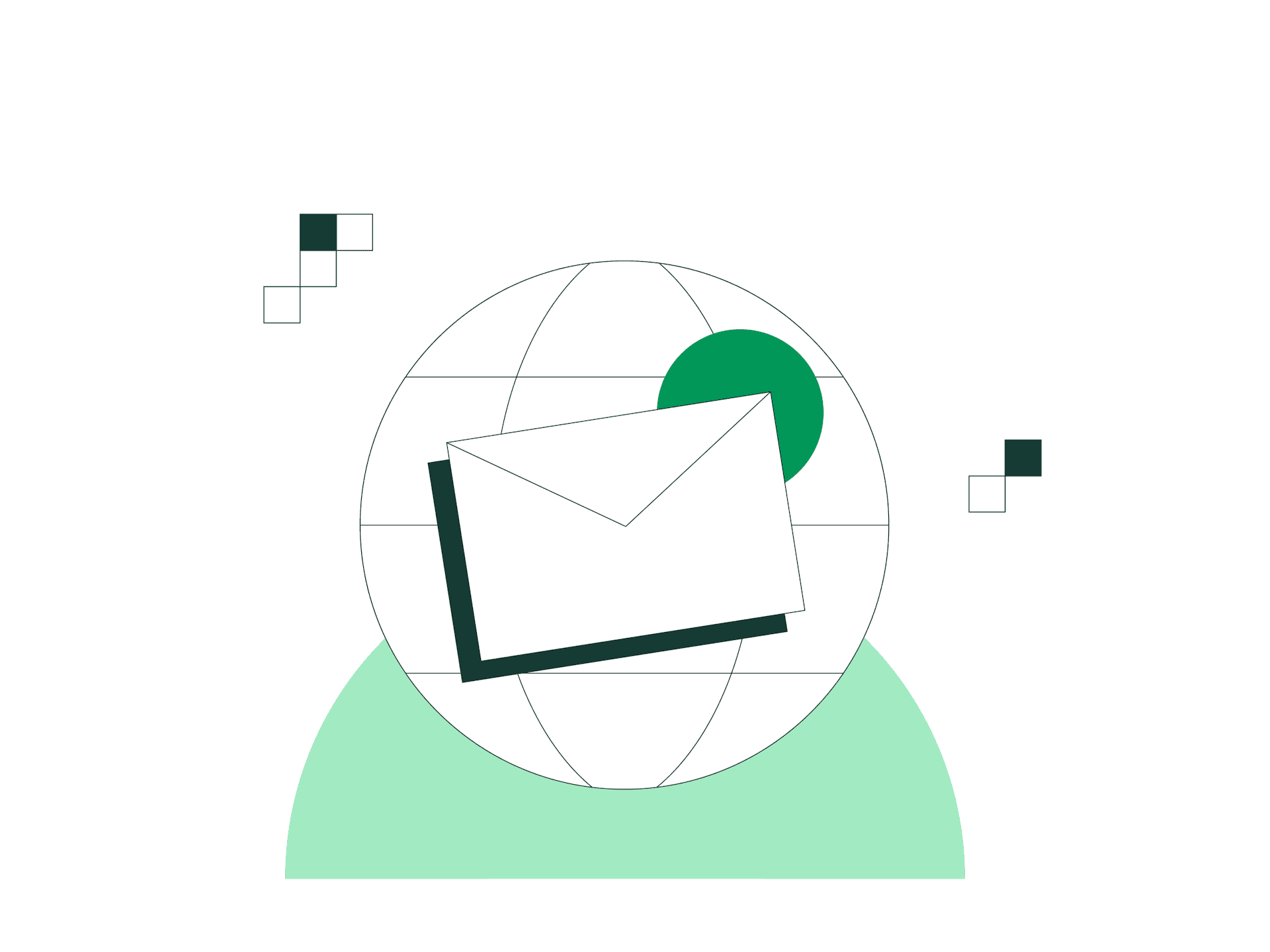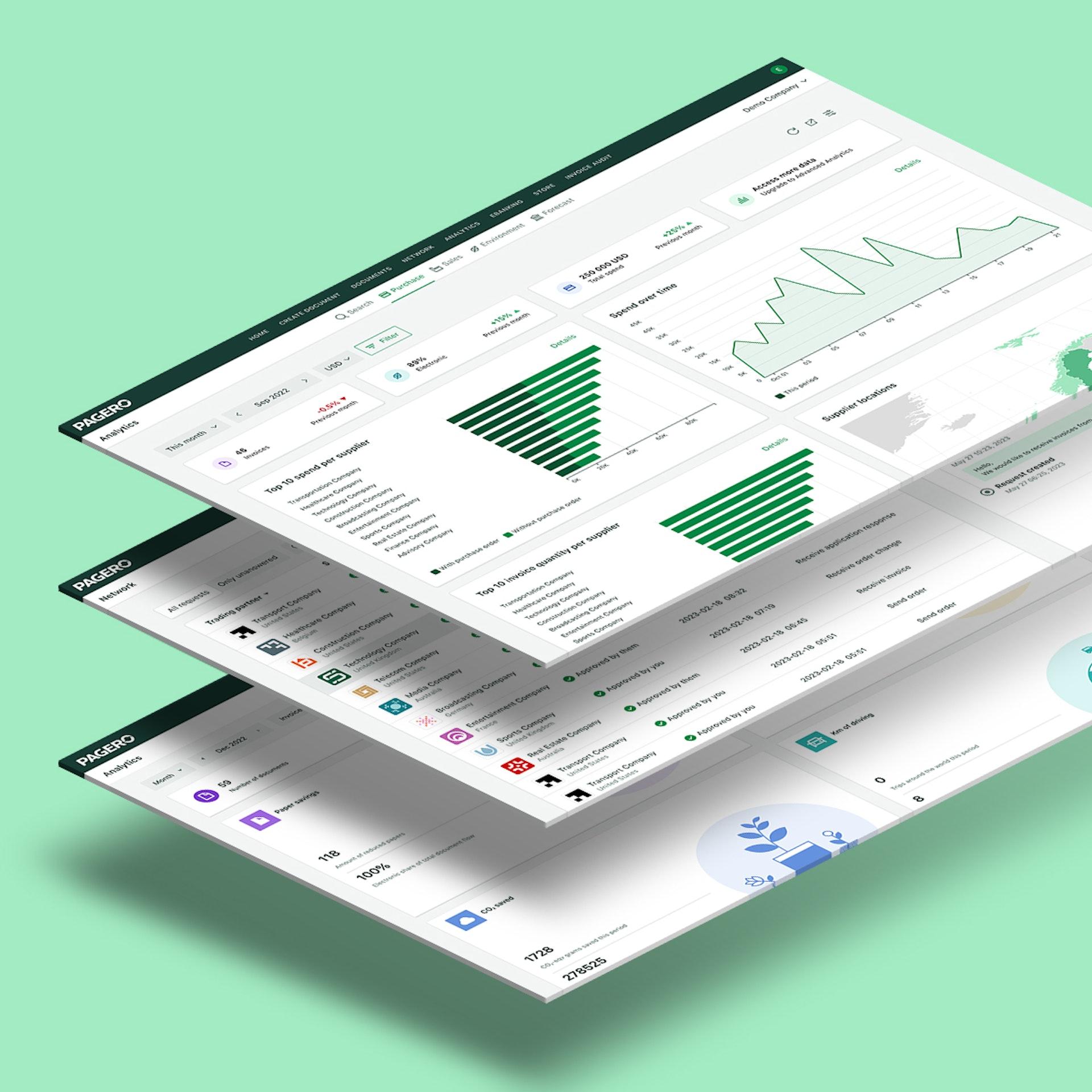E-invoicing, or electronic invoicing, refers to the process of issuing, transmitting and receiving invoices in a structured electronic format that allows for automatic and electronic processing. This digital approach replaces traditional paper and PDF invoices, offering a streamlined, cost-effective and efficient method of handling invoices. Additionally, many governments are now mandating e-invoicing as part of broader efforts to enhance tax compliance, reduce fraud and increase transparency. Read on as we explore the ins and outs of electronic invoicing.
Table of contents
1. The role of invoices in business
2. How tax administrations view an invoice
3. How do e-invoices differ from traditional invoices?
4. What is not considered an electronic invoice?
5. What are the benefits of e-invoicing?
7. What are some common e-invoicing formats and standards?
8. What is B2B, B2C, and B2G e-invoicing?
9. Market developments and growth of electronic invoicing
10. Evolution of e-invoicing models
12. Continuous Transaction Controls (CTC)
The role of invoices in business
To understand how e-invoicing differs from traditional invoicing, let’s first define an invoice. An invoice is a financial document issued by a supplier to a buyer, detailing the goods or services provided, their quantities and the agreed-upon prices. It serves as a request for payment, listing payment terms and the due date. It may also include information about the taxes that are due on the purchase. Invoices are essential for maintaining accurate financial records and ensuring proper business transactions.

How tax administrations view an invoice
Tax administrations around the world view invoices differently based on their fiscal and commercial significance.
Fiscal Document with Commercial Elements: In many jurisdictions, particularly in Latin America and Africa, as well as some jurisdictions in Europe, Asia and the Middle East, an invoice is primarily seen as a fiscal document that includes some commercial elements. This perspective emphasizes the importance of the invoice for tax compliance and revenue collection.
Commercial Document with Fiscal Elements: In the United States, Canada, most jurisdictions in Europe and some jurisdictions in Asia and the Middle East, an invoice is primarily seen as a commercial document that includes some fiscal elements. This perspective focuses on the invoice's role in business transactions while also ensuring it meets necessary tax requirements.
How do e-invoices differ from traditional invoices?
An electronic invoice (e-invoice) is a digital document that facilitates seamless exchange of invoice information between a supplier and a buyer. It is issued, transmitted, received, processed and stored using specific data formats such as XML or other structured data formats that can easily be processed by ERP systems. Unlike other types of invoices, an e-invoice remains digital throughout its entire life cycle, from issuance to archiving.
What is not considered an electronic invoice?
While many forms of digital invoicing exist, our definition of true e-invoicing specifically refers to invoices exchanged in a structured data format using a secure channel. This is crucial for ensuring there are no delivery failures, preventing interception, and enabling full automation and seamless integration between systems. In contrast, several common invoicing methods fall short of this definition:
PDF (and other image files) invoices
PDF invoices sent by email are often seen as a step toward digitalization but are not true e-invoices. Although digital, they still require manual data entry or the use of OCR (Optical Character Recognition) technology to extract information, which introduces inefficiencies and increases the risk of errors.
Structured invoices sent via email
Even when invoices are created in structured data formats like XML or UBL, sending them through email still falls short of true e-invoicing standards. Emails are not secure, making them susceptible to interception, phishing, and spam filters. They also lack the traceability and delivery assurance provided by secure e-invoicing networks.
Free on-demand e-invoicing webinar
What are the benefits of e-invoicing?
Cost savings: A major benefit is cost savings. One report revealed that automated e-invoicing will result in cost savings of 60-80% in most cases.1 When done right, e-invoicing gives you an overview and insight for cutting costs and increasing profit margins that aren't possible with PDF and paper-based methods.
Time savings: Automating the invoicing process saves time by reducing the need for manual data entry and processing. This clearly cuts costs also and allows businesses to focus on more strategic activities.
Accuracy and efficiency: Using digital methods reduces the risk of errors and inaccuracies that can occur with manual invoicing processes, such as data entry errors and lost invoices. It also enables faster processing and approval of invoices, leading to improved efficiency.
Improved cash flow management: E-invoicing allows businesses to receive payments faster, improving their cash flow management and lowering DSO. One study showed that automating the accounts receivable process (where electronic invoicing is a central component), resulted in a 32% reduction in DSO on average, which translates to 19 days.2
Electronic invoicing also provides greater visibility into invoice status and payment history, making it easier to track and manage payments.
Secure document and data exchange: Encrypted file transfer, digital signatures and secure networks all make e-invoicing the safest way to send and receive invoices. There's also no risk of invoices being lost in the mail or sent to the spam inbox.
Environmentally friendly: E-invoicing not only helps reduce paper use and lower CO2 emissions, but it also aligns with your ESG strategy by promoting sustainable practices. This approach not only reduces operational costs but also enhances brand transparency, fostering trust with stakeholders who value environmental and social responsibility.
Fulfill legal requirements: With the right service provider, e-invoicing ensures you are always up to date and compliant with local and international regulations invoicing, tax and archiving. It will even cut tax compliance costs, by between 37-39% for corporate businesses and 8-56% for private businesses, according to one report.1
Real-time delivery and processing: A good e-invoicing solution provides a real-time overview of documents' delivery and processing status on a cloud-based platform or directly in your ERP.
High-quality data: Going digital lets you access and analyze line-level data that drives business growth through better financial and procurement decisions.
Track and traceability: E-invoicing automatically tracks transaction history and the entire document journey, so you don't have to spend time doing it manually.
Remote work-compatible: Using cloud-based invoicing solutions means that tasks can be completed from anywhere without the need for extra resources like printers, scanners or the postal service.
How does e-invoicing work?
E-invoicing streamlines financial operations by facilitating systematic management of accounts payable (AP) and accounts receivable (AR) through digitalized workflows. This approach increases efficiency and accuracy in both customer and supplier invoicing. Here's a step-by-step overview of how it works for both outgoing and incoming invoices:
Sending e-invoices
- Invoice generation: The process begins with the creation of an electronic invoice within an ERP system or e-invoicing platform. This invoice is used to bill the customer for the goods or services they have provided.
- Integration and data delivery: The e-invoice is transmitted to the customer via an operator in a structured data format using secure, integrated solutions. This ensures that the data is delivered accurately and maintains its integrity.
- Validation: Before reaching the customer, the e-invoice undergoes automated validation to ensure it meets regulatory requirements and compliance standards.
- Delivery to recipient: Once validated, the e-invoice is sent to the customer in their preferred format. This customization caters to their specific invoicing needs, facilitating quick and efficient transactions.
Receiving e-invoices
- Invoice receipt: The accounts payable process begins when an electronic invoice is received from a supplier. This invoice is integrated directly into the recipient's financial system, workflow or ERP.
- Integration and data processing: The system processes the invoice data, preparing it for review and validation. The structured format ensures seamless integration and accurate data flow.
- Validation: The e-invoice is subjected to automated review to confirm compliance with established regulations, enhancing accuracy and transparency in the transaction.
- Final recording: After validation, the invoice data is processed within the financial system. This includes updating the accounts payable records and preparing the invoice for payment, thereby completing the transaction cycle.
What are some common e-invoicing formats and standards?
Every electronic invoice relies on standardized formats to ensure consistency in the structure and content of invoices, enabling seamless exchange of data between different systems. Some widely used e-invoicing standards include:
JSON (JavaScript Object Notation): JSON is a lightweight data interchange format that's easy for both humans and machines to read and write. While it's more commonly associated with web applications, JSON is also gaining traction in e-invoicing due to its simplicity and compatibility with modern programming languages.
XML (eXtensible Markup Language): XML is a versatile markup language used to define the structure and content of data in a human-readable format. It's widely used due to its flexibility and extensibility. In an XML-based e-invoice, data elements are tagged with descriptive labels, making it easy to interpret and process the information.
Peppol BIS: A standardized set of formats specifically crafted for electronic documents pertaining to procurement processes within the Peppol network. It facilitates the seamless exchange of various procurement-related documents including invoices. This standard is integral in modern e-invoicing processes, promoting interoperability and streamlined communication between different business systems across borders.
EDIFACT (Electronic Data Interchange for Administration, Commerce and Transport): EDIFACT is a global standard for electronic data interchange (EDI) used across various industries. While it has been used traditionally for paperless exchange of business documents, including invoices, it's also being adapted for modern e-invoicing processes.
What is B2B, B2C, and B2G e-invoicing?
Business-to-Business (B2B) e-invoicing: This involves the electronic exchange of invoices between businesses. It streamlines the invoicing process, automates approval workflows and enhances cash flow management. Key drivers for this kind of B2B invoicing include the need for efficiency, cost reduction and seamless collaboration within supply chains.
Business-to-Government (B2G) e-invoicing: Here, businesses electronically submit invoices to government agencies. This practice is driven by a broader push for digital transformation in public procurement. B2G e-invoicing aims to improve transparency, reduce paperwork and enhance accountability.
Business-to-Consumer (B2C) e-invoicing: This is focused on consumers. It involves generating electronic bills for individual customers, often integrated with payment systems. The primary drivers for B2C e-invoicing are convenience and user-friendly payment processes. Integration with online banking solutions allows consumers to manage payments.
Market developments and growth of electronic invoicing
Market growth: The global e-invoicing market is experiencing remarkable growth, rising from an estimated 55 billion in 2019 to 125 billion in 2024, representing a healthy Compound Annual Growth Rate (CAGR) of 17.84% (Billentis). Similarly, the market size has expanded at a CAGR of 15.66%, growing from $4.3 billion in 2019 to $8.9 billion in 2024. This growth is expected to accelerate, with the market size projected to reach $23.7 billion by 2028, corresponding to a CAGR of 26.82%.
This growth is fueled by several factors, including the expansion of the e-commerce industry, the widespread adoption of advanced IT solutions across various sectors and technological advancements such as web- and software-based invoicing applications. The shift from traditional paper or PDF-based invoicing to electronic alternatives is driven by the need for faster, more accurate and more cost-effective invoicing methods.
Regulatory impact: Many governments worldwide have introduced electronic invoicing and digital reporting mandates to modernize tax compliance, with many more countries projected to introduce requirements within the next two to four years. These mandates often include continuous transaction controls (CTCs), which enable real-time tax and data reporting, allowing governments to collect business transaction data in an ongoing manner. For tax departments, this means transitioning away from post-audit methods of tax reporting to frameworks that prioritize data accuracy and speed. The regulatory push is not only about compliance but also about combating tax evasion and fraud, improving financial transparency and making tax systems more efficient.
Integrated Digital Trade (IDT): IDT refers to a comprehensive approach that automates business transactions and financial operations beyond just electronic invoicing. It encompasses processes such as payment, invoice financing, electronic procurement and tax automation. The adoption of IDT varies based on distinct value propositions and differs significantly between small and medium-sized enterprises (SMEs) and large corporations. SMEs tend to focus more on integrating financial processes in response to regulatory mandates, while large enterprises proactively initiate projects to automate supply chain processes.
The convergence of market growth, regulatory impact and IDT is reshaping the e-invoicing and e-reporting sector, indicating a move towards a more interconnected and digitally-driven global economy. Businesses must adapt to these changes to stay competitive and compliant in the evolving digital landscape.
Evolution of e-invoicing models
The progression of electronic invoicing from paper and PDF invoices to more sophisticated models reflects an ongoing search for efficiency and accuracy. Initially, businesses relied on paper-based invoices and whilst these were familiar and could be easily handed over or mailed, they were fraught with disadvantages. The manual nature of processing these invoices was not only time-consuming and costly but also prone to errors and difficult to track. The environmental impact of paper usage and the lack of security posed additional concerns.
As digital technologies advanced, the two corner model of Electronic Data Interchange (EDI) emerged as a solution, enabling the direct exchange of invoices between two businesses. This automation brought about faster processing and payment cycles, marking a significant improvement over paper invoicing. However, EDI is not without its challenges. The high setup costs and complexity of these systems requires technical expertise and the rigid standards often mean limited flexibility for businesses.
The three-corner model, or closed network e-invoicing, simplifies connectivity by allowing businesses to connect to a single intermediary network that facilitates the exchange of e-invoices. This model reduces the complexity associated with direct EDI connections. Despite its benefits, it also often forces smaller businesses to join multiple networks at the request of their larger customers, adding additional costs in the form of multiple network fees.
The four-corner model, or open e-invoicing through interoperability, allows businesses the flexibility to choose their preferred service providers who then communicate with each other through agreed protocols. Businesses benefit from the scalability of the model, which facilitates the addition of new trading partners and expansion of operations. As illustrated in the comparison chart below, enhanced security features and more efficient processes make the four-corner model even more attractive and the preferred choice for modern e-invoicing systems such as Pagero.
| Paper/PDF | EDI (2 corner) | Closed e-invoicing network (3-Corner) | Open e-invoicing network (4-Corner) | |
|---|---|---|---|---|
| Speed | No | Yes | Yes | Yes |
| Automation | No | Yes | Yes | Yes |
| Security | No | Yes | Yes | Yes |
| Ease of Tracking | No | Yes | Yes | Yes |
| Environmental Friendliness | No | Yes | Yes | Yes |
| Simplified Connectivity | No | No | Yes | Yes |
| Reduced Complexity | No | No | Yes | Yes |
| Cost Efficiency | No | No | Yes | Yes |
| Flexibility in Service Providers | No | No | No | Yes |
| Scalability | No | No | No | Yes |
| Greater Reach | No | No | No | Yes |
Is e-invoicing mandatory?
As digital transformation continues to reshape financial practices worldwide, many governments are mandating the adoption of electronic invoicing. This shift is driven by the need for greater efficiency and visibility in tax reporting. While the specific requirements and timelines vary, the trend towards making e-invoicing mandatory is unmistakable.
In many cases, the rollout of mandatory electronic invoicing starts with B2G (business-to-government) transactions and then expands to cover B2B (business-to-business) transactions as well.
Regional trends in e-invoicing mandates:
- Europe
The upcoming VAT in the Digital Age (ViDA) initiative, proposed by the European Commission, is set to further standardize and expand e-invoicing across Europe. ViDA aims to modernize VAT reporting by implementing real-time, digital reporting for businesses, helping to reduce VAT fraud and improve compliance across the EU. Countries like Germany, Sweden and Italy already mandate electronic invoicing for B2G transactions, while Italy has also extended this to B2B, with many more countries on a similar trajectory such as Germany, Poland, France and Belgium. - Latin America
Countries like Mexico, Brazil and Chile have been early adopters of mandatory e-invoicing, covering both B2G and B2B transactions. E-invoicing in this region is closely tied to VAT collection and reducing tax evasion, making it a key tool for government oversight and transparency. - Asia
India, Vietnam and Saudi Arabia are advancing e-invoicing mandates. India uses a threshold-based system, while Saudi Arabia have adopted comprehensive e-invoicing for B2G and B2B transactions as part of efforts to improve tax compliance and digitize their economies.

Source: VAT gap in the EU 2023 report
Continuous Transaction Controls (CTC)
Continuous Transaction Controls (CTC) are at the forefront of the e-invoicing revolution. By enabling tax authorities to collect transaction data in real-time or near-real-time, CTC models facilitate a more efficient and transparent tax system. This approach transitions from retrospective reporting to immediate data capture, allowing for better tax audits and reduced opportunities for fraud.
CTC models vary, but they can be broadly categorized into five types:
Real-time reporting (RTR)
Under this model, the supplier is required to report a portion of the invoice to their tax authority in real time after issuing it to the buyer. The invoice must adhere to a mandatory format and include specific required data fields.
Clearance
Under Clearance models, businesses need to ‘clear’ or ‘authorize’ invoices via tax authority platforms before they can send them on to their customer.
Centralized exchange (CE)
A central platform enables the exchange of e-invoices between buyers and seller while passing on the information to the tax authorities at the same time.
Peppol and Peppol CTC
Peppol is a network that enables the electronic exchange of various documents, including electronic invoices. To participate in this network, taxpayers must utilize the services of a Peppol Service Provider, which facilitates the secure exchange of documents between parties within the Peppol network. This is a 4-corner model, ensuring standardized and compliant communication across different systems.
Hybrid (DCTCE and CE)
This hybrid model combines elements of Decentralized Continuous Transaction Controls and Exchange (DCTCE), like Peppol, with a Centralized Exchange (CE) system. It allows for flexibility in document exchange through decentralized networks, offering businesses the choice of different technical standards, while still maintaining centralized oversight and control via a government-managed platform. This approach provides the best of both worlds—enabling automation through decentralized processes while ensuring compliance through centralized mechanisms.
VAT in the Digital Age (ViDA)
The ViDA initiative will introduce mandatory digital reporting of cross-border transactions within the EU, along with compulsory e-invoicing. This will require businesses to overhaul their invoicing processes, including accounts payable and receivable, as well as the information systems that support these functions.
Businesses outside of the EU, such as those in the UK, will also need to comply with these new digital reporting regimes, which will likely mean additional administrative costs.
ViDA’s proposals center around three key pillars: Digital Reporting Requirements, the Platform Economy and a Single EU VAT Registration. These pillars aim to modernize tax processes across the EU, making the system more compatible with today’s digital economy.
Businesses are strongly encouraged to begin preparations early, adapting their systems to meet the new digital reporting requirements and ensuring they can execute real-time, accurate data transmission to tax authorities.
While these changes may initially pose challenges, the long-term impact of ViDA is expected to be beneficial for businesses, governments and the public, offering more efficient processes, reduced manual workloads and a more robust framework for VAT compliance.
Implementing e-invoicing
Transitioning to e-invoicing is a crucial step toward digitalization and efficiency, offering more than just a paperless solution. It streamlines financial workflows, boosts compliance and enhances real-time data management. To navigate this shift effectively, here are key steps to consider:
Assess your landscape: Start with a thorough assessment of your current systems and processes. Understand how your ERP systems work, how you issue and receive invoices and how much control you have over paper and PDF workflows. This will help you get a clear sense of where to begin and how to approach electronic invoicing.
Strategic planning: Develop a well-rounded strategy that integrates e-invoicing into your broader digital transformation goals. Consider how it aligns with your internal objectives and external compliance requirements, ensuring it supports a holistic approach to modernizing trade processes.
Supplier and customer engagement: Work with your suppliers and customers to ease the transition. Offer flexibility with data formats and transmission methods to make the shift easier for them. Highlight benefits like quicker payments and better financing options to get them on board.
This text was originally published 18 February 2021 and last updated 23 September 2024.
Ready for the next step?
Sources
1 Bruno Koch, "The E-invoicing Journey 2019-2025," 4.1.5. https://www.billentis.com/assets/reports/The_einvoicing_journey_2019-2025.pdf
2https://www.pymnts.com/wp-content/uploads/2023/07/PYMNTS-How-Automations-Reduce-Receivables-Delays-July-2023.pdf
Topics:

Stay in the loop with our newsletter

Get in touch
Interested in getting started or learning more? Leave your contact details here and we will reach out to you!

